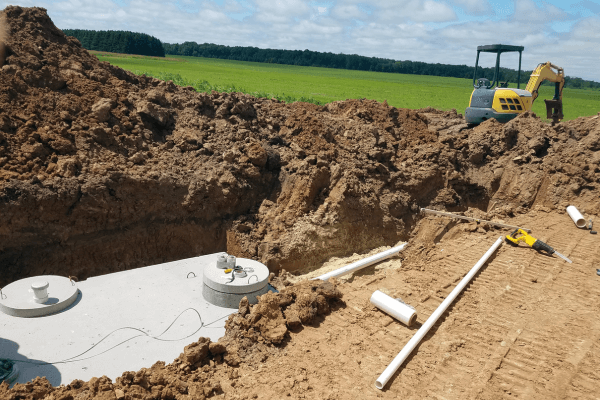Septic tanks are crucial components of wastewater management, especially in areas where there is no access to centralised sewerage systems. At Limpiezas Domingo e Hijos, we are experts in their maintenance and understanding. Although they are common in many areas, knowledge about their operation and maintenance is essential but often misunderstood. This article provides an in-depth look at what septic tanks are and how they operate.
What is a septic tank?
A septic tank is an underground wastewater treatment system. It works by using biological and physical processes to break down and treat wastewater from households and businesses. These systems are indispensable in places without access to municipal sewage networks. They are an effective and sustainable solution for wastewater management in decentralised environments, as confirmed by the US Environmental Protection Agency (EPA) in its publications. These systems not only treat wastewater, but also protect public health and the environment by preventing soil and groundwater contamination.
Types of septic tanks
There are several types of septic tanks, each suitable for different conditions and needs. Conventional, single-tank tanks are the most common and are widely used due to their simplicity and efficiency. On the other hand, oxidation pits and multi-chamber systems offer more advanced treatment and are ideal for properties with less permeable soils or those requiring a higher level of treatment. A study by the Institute of Water Engineering (IWA) details the differences and applications of each type of septic tank, providing useful guidance for the selection of the most appropriate system. Por otro lado, las fosas de oxidación y los sistemas multicámara ofrecen un tratamiento más avanzado y son ideales para propiedades con suelos menos permeables o que requieren un mayor nivel de tratamiento. A study by the Institute of Water Engineering (IWA) details the differences and applications of each type of septic tank, providing useful guidance for the selection of the most appropriate system.
Components of a septic tank
The typical septic tank system includes two main components: a septic tank and a drain field or infiltration bed.
- The Septic Tank: This is where the wastewater from the house initially flows. In the tank, solids settle to the bottom, forming sludge, while oils and fats float to the surface, creating a scum layer. The residual liquid (effluent) remains between these two layers. The tank retains solids and allows the relatively clear effluent to flow into the drain field.
- The Drainage Field: Also known as the infiltration bed, it is an integral part of the system. Here, the effluent leaving the septic tank is evenly distributed in the soil. The soil acts as a natural filter, removing bacteria, viruses and additional nutrients from the effluent before it reaches the groundwater. The effectiveness of the drainage field depends on the soil type and proper planning of the system.
How does a septic tank work?
The operation of a septic tank begins in the septic tank, where preliminary separation and decomposition takes place. Solids settle to the bottom of the tank, and anaerobic microorganisms break down the organic matter. This process reduces the volume of solids and produces gases such as methane and carbon dioxide. The liquid effluent then flows into the drain field, where it percolates through the soil. This natural filtration process is crucial to remove remaining pollutants and protect groundwater.
Maintenance and care
Proper maintenance is vital to the proper functioning of a septic tank. This includes regular inspections and pumping of the tank to remove accumulated solids. According to the EPA, it is recommended to inspect the system at least once every three years and to pump the tank every three to five years. However, the frequency may vary depending on tank size and system usage. Inadequate maintenance can lead to serious problems, such as groundwater contamination and the need for costly repairs.
Common problems and solutions
The most common problems in septic tanks include blockages, overflow and bad odours. These problems are often the result of inadequate maintenance, excessive use of household chemicals or the introduction of non-biodegradable materials into the system. Early identification and resolution of these problems is crucial to avoid major damage and costly repairs. The University of Minnesota offers a detailed guide to common septic tank problems and how to address them.
Case studies and best practices
The importance of proper maintenance and knowledge of septic tank operation can be illustrated by real case studies. For example, in one case in a rural community, lack of regular maintenance led to a total collapse of the septic system, resulting in contamination of the local groundwater. The solution involved not only repairing the system, but also an educational campaign for residents on the importance of septic tank care.
Advice for homeowners
For septic tank owners, there are several key tips that can help keep your system running efficiently:
- Regular Inspections: As mentioned above, regular inspection and pumping of the tank is essential.
- Careful Water Use: Reducing excessive water use can avoid overloading the system. This includes repairing leaks and considering the use of energy efficient appliances.
- Be careful what you discharge: Avoid dumping harmful chemicals, fats, oils, grease and non-biodegradable materials into the system.
- Drainfield Care: Do not drive or park vehicles on the drainfield, as this can compact the soil and damage the pipes.
In conclusion, understanding what a septic tank is and how it works is essential to ensure a safe and efficient wastewater system. Regular maintenance and careful use can significantly prolong the life of a septic system and prevent costly problems. If you need expert advice or maintenance services, Limpiezas Domingo e Hijos is here to help you. Our experience ensures that your septic system is in the best hands.

